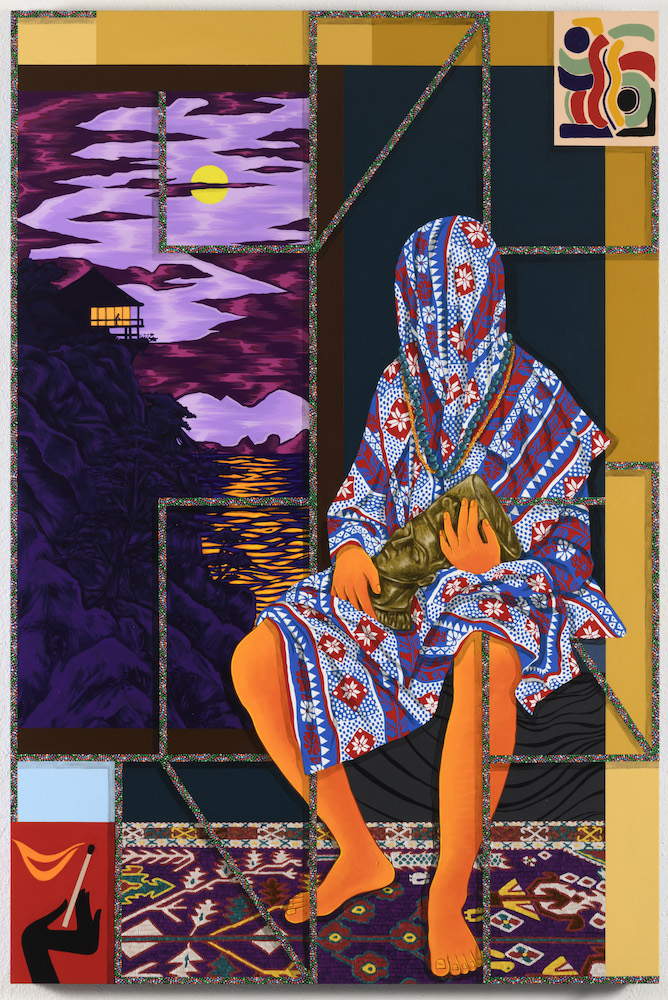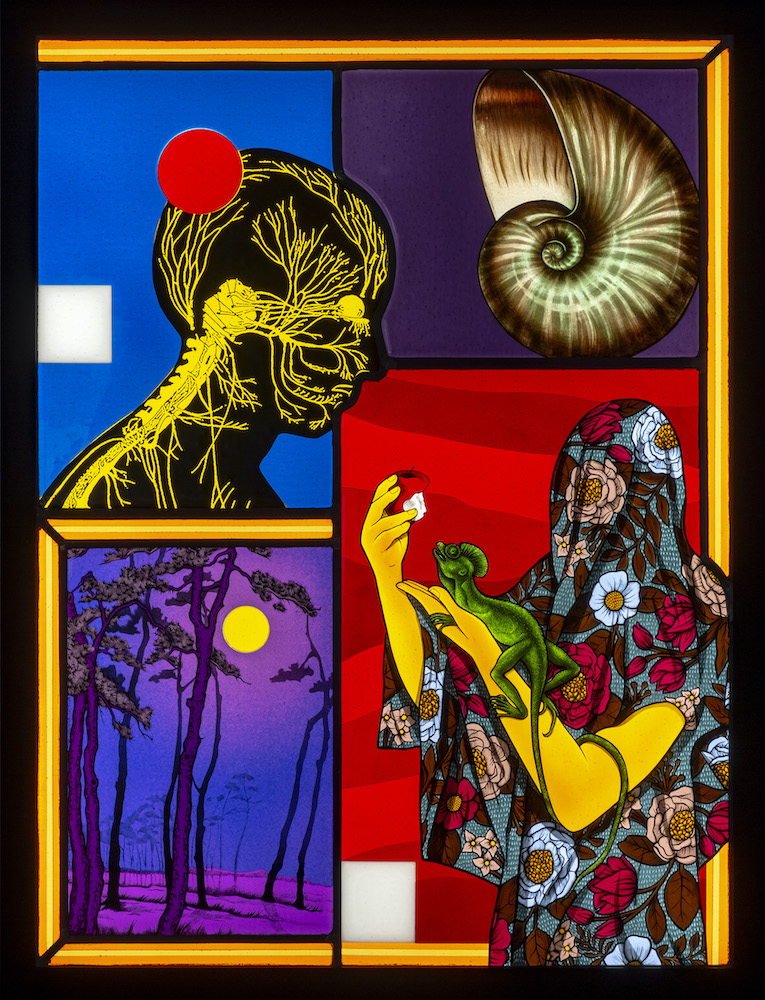Your cart is currently empty!
Brilliant Veils Amir H. Fallah Creates Vibrant Artworks That Question Cultural Boundaries

Entering a room of portraits by Amir H. Fallah, the first thing you’ll notice is that you can’t see their faces: the figures are cloaked. In one, the subject sits draped in a richly patterned blue-and-purple shawl, cradling what looks like a gilded African head in its lap. In another, a figure with purple arms strikes a pose seemingly drawn from ancient Near Eastern art, swathed in a lustrous cloak with a dragon design, the creature’s snarling face overlapping the subject’s.
“I think of all of my work as kind of psychological portraits, and not literal portraits,” Fallah says. “Is a portrait someone’s physical likeness, which really doesn’t tell you anything about who they are? Or is a portrait like someone’s experiences, their personality, their beliefs? So with the veiled figures, you have to focus on everything else to try to figure out who this person is, from the fabric that they’re covered in, the objects they surround themselves with.”
Yet these veiled portraits constitute just one facet of Fallah’s oeuvre. A new solo survey show at UCLA’s Fowler Museum—known for its ethnographic holdings—demonstrates just how far the artist’s omnivorous vision has expanded over the past decade. Titled “The Fallacy of Borders,” the exhibition includes painting, sculpture and even a set of stained-glass windows. No less significantly, it also reveals the breadth of Fallah’s interests, which span from skateboard culture and textile design to scientific illustration; from Persian miniatures and modernist abstraction to obscure ephemera. Melding elements of high and low, East and West, ancient and modern, his works doggedly question boundaries that separate people, cultures and genres. At times it almost looks as if he took elements from various wings of an encyclopedic museum and threw them into a blender, then laid out the results into a dreamlike rebus.
That sense of drawing from a medley of sources is embedded in Fallah’s biography. Born in 1979 in Tehran during the Islamic Revolution, Fallah and his family first moved to Turkey and Italy before coming to the US as refugees. He got his graduate degree at UCLA before settling in Los Angeles, where he was steeped in a rich Latino culture. “Yeah, I’m all over the place,” he says. “I’m a cultural mutt. My wife is Puerto Rican, and my son is half Iranian, half Puerto Rican and American, you know? And he looks white. Also, I’m very dark-skinned for an Iranian, so nobody ever thinks I’m Iranian. My wife happens to look Irish. So none of us looks like who we quote-unquote ‘are.’”

In 1996, Fallah started Beautiful/Decay, a DIY zine, which grew into a full-color publication and attracted a wide cult following (and is featured prominently in the show). In the decades since, his practice of sampling snippets of disparate imagery and design has expanded through the use of online digital archives, from which Fallah liberally gleans to discover elements for his works. “A lot of times I don’t even know the origins of a lot of them,” he explains. “So I don’t care about its initial context. I’m seeing it as the raw ingredients, that I’m giving new life to.”
In combining images from far-flung sources, Fallah is only building on the sort of fluid cultural exchanges that are rooted in history. As an example, he notes how dragons, often regarded as a Chinese motif, can also be found in Persian artwork. Sitting before the largest painting in the show, he points to a pair of angels on the left half of the canvas. “They look Asian, but they’re actually Persian, they’re from a Persian miniature,” he says. “So am I appropriating something that’s Asian? Or am I appropriating something that’s my own?”
The wall-sized work also includes the image of an Alpine maiden from an old-time matchbox cover, a pair of mirrored flamingos, and a hand holding out a pigeon like a peace offering, laid out across a grid-like armature. The mirror patterns suggest a Rorschach print, with dualities of good and evil, or opposing perspectives, while a Rubik’s Cube hints at the need for addressing puzzle-like challenges. But the title, Break Down the Walls (2022) reveals a darker reality, alluding to the policy of separating migrant children at the border during Trump’s presidency. The issue holds special relevance to Fallah, himself an immigrant, with a son the same age as many of those detained.
“I want to visually seduce the viewer with ornamentation, decoration, bright colors, patterning, and make them spend time with the work,” he elucidates. “And the more they spend time with the work, they realize that it’s not just like a candy-coated sugary snack. It’s very much about reality. It’s a way to make the dark realities of the world more swallowable.”
In recent years, he has expanded the range of sources that inspire him to include evocative lines of text, and themes from children’s stories that he reads to his young son. But although his dazzling colors and designs may look psychedelic, Fallah himself has no interest in drug culture. “The irony is I don’t even drink,” he laughs. “I’ve never smoked a cigarette, never smoked pot.” Instead, they draw from his fascination with graffiti and skateboarding, and with digital imagery. “These are also the colors of advertising, or of illustration,” he reflects. “I feel like I’m just using the palette of our time. Which is loud, bold and in-your-face.”
The effect tilts into the realm of the sublime in his stained-glass windows, which employ modernist geometries and primary colors as a scaffold for cryptic tableaux of veiled figures, posed amid natural history elements like lizards and mollusks and eerie anatomical illustrations; illuminated from behind, they lend the gallery the mystical aura of a chapel.

Beyond the Fowler exhibition, Fallah will also be having two other visible projects around LA to coincide with Frieze week, making the winter something of a Fallah-palooza. In February he’s opening an exhibit of new paintings at Shulamit Nazarian, called “A War on Wars,” which he sees as a “meditation on all the horrible things of war, not just in Iran.”
On the building’s façade, he’s installing a large neon artwork, created with the neon artist matt dilling, inspired by the current protests in Iran. Titled Chant, the piece depicts a female-faced sun encircled by the words “Woman Life Freedom” in English, Farsi and phoneticized Farsi. The sun had long been a Persian national symbol; when the Pahlavi dynasty took over the country, they removed the female face from its depictions. In restoring it in his radiant public artwork, Fallah honors the Iranian women who are currently protesting with such bravery and resolve. When it’s sold, 100% of the funds will be donated to human rights charities.
This attests to one final aspect of his practice: that beneath Fallah’s curiosity lies compassion. Not merely an act of eager cultural mixology, for all its crafty flair, his work feels like a private assertion of hope. It’s all about the possibility, and durability, of cross-cultural dialogue. Rooted in Los Angeles, with its irresistible amalgam of cultures and visual stimuli, but impelled by a fascination with the visual expression of diverse peoples and geographies, he’s both an LA artist and a global one. Which makes him perhaps uniquely qualified to address some of the issues of nationality and identity that confront us today.
“I want to make work that’s about this period in time that we’re living in—the good, the bad, the ugly,” he says. “I want people to like look back and be like, oh, this work marks this period in human history. It’s not nostalgic for a period in time that he wasn’t in. It was exactly about the time that he was in, right now.”